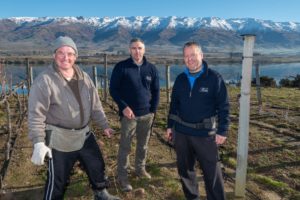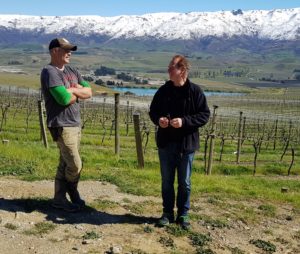
We are just starting the new growing season and it seems budburst will be way ahead of any previous season at Misha’s Vineyard and in fact one of the earliest in Central Otago. Having joined as Vineyard Manager/Viticulturalist at the beginning of June, I’ve now walked over just about all of the 26 hectares of vineyard having hand pruned all 65,000 vines along with our permanent team Aaron and Neil and a cameo appearance from Alan Buckingham.
It’s been good opportunity to take a closer look at the vines as well as the rocky soils on these steep and windswept westerly slopes that overlook Lake Dunstan. What has struck me is that the soils are more complex than I had originally thought with red and yellow clays at shallow levels mingling with gravels and silts. These soils are free-draining but the clay deposits do allow for the capacity to hold water and release it slowly over the hotter months.

With our pruning, it’s been great to have been able to make some small tweaks to how we set up the vines for the coming season. The number of buds left at pruning will determine the shoot density and potential yield.

Our Dress Circle block, where we grow Pinot Gris, is one of the blocks where we’ve had less than optimal yields over the last couple of seasons. This is unusual as this variety is normally pretty hardy although we have had two difficult seasons due to weather extremes. It is a very windy block which means water evaporates quickly and also this block had a lot of the fescue clumps that we’ve now removed. So with the grass clumps removed, and with a good application of our own compost, along with increased irrigation and nutrition this season, we hope to see an increase in yields for this block.

After a very cool 2017 season, and an off-the-charts warm season in 2018, my strategies for the vineyard for this season include ensuring we try and bring everything back into balance after these two extraordinary seasons. I will ensure there is plenty of irrigation on all the blocks and maintain the rate as it looks there was some water stress last year in the unseasonal hot weather. And on our Sauvignon Blanc block, we’ll really turn up the water volume as Sauvignon Blanc vines are much more thirsty than Pinot Noir and these vines grow on a very steep block with a lot of afternoon sun impact. With early indications that this will also be a warm (and early season) I’m planning to increase nutrition to the vines through fertigation and also plan to increase foliar nutrition based around seaweed extracts to help minimise the impacts of weather related stress.
I am really looking forward to the coming season!
Tim
